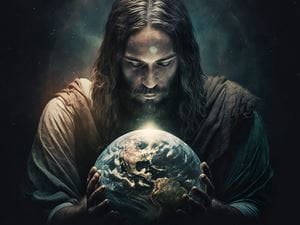
Everyone likes to know how things work. No sooner do we learn to pick up objects, like our childhood toys, than we hold them up to the light and look them over to see which bits do what. It’s only natural that we take a similar approach whenever it comes to faith.
There are books, running to hundreds upon hundreds of pages, attempting to describe (in excruciating detail) the works of God. For many things, however, there are no satisfying explanations to be found; and we must learn to live with mystery, while still having faith.
It’s hard, for instance, to pin down how Christ’s death on the Cross resulted in our salvation. Some have tried (their efforts are called theories of atonement, and some are more persuasive than others) but nobody has yet come up with an agreed-upon answer that’s accepted all over the Christian world. Many would fiercely defend a particular view.
Christ’s death, we must remember, was one part (albeit a significant part) of his earthly life. It certainly wasn’t his Crucifixion alone that saved us. In the Nicene Creed, the phrase ‘for us and for our salvation’ doesn’t come right before ‘he suffered death and was buried’. It comes, rather, before the whole section about Christ’s work on earth. It would clear up the matter, I think, if every sentence in this passage began, ‘for us and for our salvation’:
· For us and for our salvation, he came down from heaven.
· For us and for our salvation, he was incarnate by the Holy Spirit of the Virgin Mary and was made man.
· For us and for our salvation, he was crucified under Pontius Pilate.
· For us and for our salvation, he suffered death and was buried.
· For us and for our salvation, he rose again in accordance with the Scriptures.
· For us and for our salvation, he ascended into heaven and is seated at the right hand of the Father.
· For us and for our salvation, he will come again in glory to judge the living and the dead.
Together, the Incarnation, the Crucifixion, the Resurrection, the Ascension, the Second Coming, and the Final Judgement – in short, everything Christ has ever done and will ever do – throws open the door to salvation. St. Paul takes care to remind us, moreover, that salvation is an ongoing process; by God’s grace, we’re ‘being saved’ (1 Corinthians 1.18).
How, though, do these landmarks in the life of Christ work together to save us? In truth, we don’t really need to know. Consider your phone (or tablet), on which you’re likely reading this. You probably didn’t design it. You probably don’t have a Scooby-Doo how the tech works. This doesn’t matter in the slightest. You’re able to benefit from it anyway.
Similarly, we don’t have to know how the Incarnation, the Crucifixion, the Resurrection, the Ascension, the Second Coming, and the Final Judgement end up with our salvation; we simply need to trust what we believe – ‘that is all ye know on earth, and all ye need to know’. However, we’re welcome to ponder these mysteries until we see God face to face.
What we should refrain from doing is imposing our own ideas on other believers and labelling those we disagree with as heretics. Different stances prevail in different circles (evangelicals, for example, typically believe that Christ was punished instead of us for the sins we commit). Like I say, though, there are several views on how the Crucifixion saves.
It’s notable that, compared to the Crucifixion, there’s little debate around what role the Incarnation, the Resurrection, the Ascension, the Second Coming, and the Final Judgement have in saving us because the Crucifixion peels off so much of our attention. It’s as if we believe, mistakenly, that redemption is only to be found on the Cross – not in Bethlehem, in the Garden Tomb, on the Mount of Olives, or at the right hand of the Father.
There is a time in the Church’s year (a ‘season’, as the speaker in the Book of Ecclesiastes would say) to commemorate all the main events in the life of Christ: Advent for his Incarnation, Holy Week for his Passion… We should refrain from unfurling the calendar and planting a huge ‘X’ on any one day (writing, ‘this is the day that salvation happened!’), unless we make the time to put such a mark beside every day that Christ walked on earth.
And so, this Easter, let us not lose focus on the wider story, the Gospel of Salvation, that Christ lived out. For us, and in order to save us, Christ did many things. Yes, he died on the Cross and rose again (‘alleluia!’), but he had other, equally significant, achievements besides.
In light of these other achievements is the Crucifixion better understood; and in light of the Crucifixion, I would submit, are those other achievements more fully grasped.
4/5/2025 12:54:27 AM

